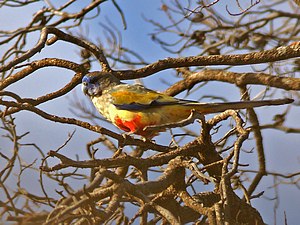Blood-bellied Parakeet
| Blood-bellied Parakeet | ||||||||||
|---|---|---|---|---|---|---|---|---|---|---|

Blood-bellied Parakeet |
||||||||||
| Systematics | ||||||||||
|
||||||||||
| Scientific name | ||||||||||
| Northiella haematogaster | ||||||||||
| ( Gould , 1838) |
The Blutbauchsittich ( Northiella haematogaster ) is a type of authentics Parrots . It belongs to the fauna of Australia and is particularly widespread in the southeast and central south of Australia. There are four subspecies. The species is fully under legal protection in Australia.
features
Blood-bellied parakeets reach a body length of up to 29 centimeters. It is named after the red plumage on the lower abdomen that pulls down the legs. Sometimes there is also partially yellow plumage. The chest region, on the other hand, like the neck, is gray to mauve-blue. The beak is also gray, but the face mask is blue. The top of the wing is also colored blue. The females are similar to the males, but they are often a little paler and have less red on the stomach. The blue face mask is less extensive. The female's beak is smaller than that of the male and the upper beak is narrower.
Young birds, like the female, are somewhat duller in color. The red spots on the belly are very small. The underside of the body is light yellow. They have noticeable under wing stripes. The beak, which is grayish horn-colored in the adult birds, is still pale yellowish in them.
The flight is wavy and differs only slightly from that of the species of the flat-tailed parakeet . Unlike these, however, they keep their wings outstretched during the gliding phases.
Behavior and habitat
Blood-bellied parakeets colonize semi-arid and arid areas with a loose tree population. This includes grassland with isolated trees and bushes, open forms of the Mallee , dry bushland, gallery forests and trees near farmland. Blood-bellied Parakeets live in pairs or in small flocks. Occasionally smaller swarms also form at water points and particularly rich feeding places. One of the largest swarms observed so far was one that comprised a hundred blood-bellied parakeets that were associated with multi-colored parakeets . However, they are mostly observed in flocks that contain fewer than 11 specimens. They are considered to be predominantly local birds.
Blood-bellied parakeets eat seeds from grass, herbaceous plants, shrubs and trees as well as from fruits, flowers, berries, nectar and insects and their larvae. They also like to pick up fine grit , sand and charcoal .
Blood-bellied parakeets are cave breeders that usually breed in a cave in a branch or tree trunk. The nesting site is chosen by both partners. The entrances to the breeding caves are often only narrow crevices near the ground. The nest holes can still be very deep and are occasionally below the surface of the earth. The female lays between four and seven eggs. The incubation period is 19 to 20 days.
Systematics
The species used to be counted among the singing parakeets . However, biochemical studies have now shown that this classification is not justified. Rather, they are more closely related to the ringed parakeets and the flat-tailed parakeets in the narrower sense.
-
Genus: Blood-bellied Parakeets ( Northiella )
- Species: Blood-bellied Parakeet ( Northiella haematogaster )
- Subspecies: Gelbsteißsittich ( Northiella haematogaster haematogaster )
- Subspecies: red- tailed parakeet (
- Subspecies: Naretha Parakeet ( Northiella haematogaster narethae )
- Subspecies: pale yellow- tailed parakeet ( Northiella haematogaster pallescens )
- Species: Blood-bellied Parakeet ( Northiella haematogaster )
supporting documents
Individual evidence
literature
- Joseph M. Forshaw : Australian Parrots. 1st German-language edition. Volume 2, Arndt-Verlag, Bretten 2003, ISBN 3-9808245-2-7 .
Web links
- Northiella haematogaster inthe IUCN Red List of Threatened Species 2013.1. Listed by: BirdLife International, 2012. Retrieved September 28, 2013.
- Videos, photos and sound recordings for Northiella haematogaster in the Internet Bird Collection